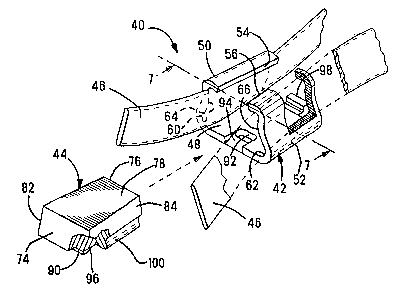Some of the information on this Web page has been provided by external sources. The Government of Canada is not responsible for the accuracy, reliability or currency of the information supplied by external sources. Users wishing to rely upon this information should consult directly with the source of the information. Content provided by external sources is not subject to official languages, privacy and accessibility requirements.
Any discrepancies in the text and image of the Claims and Abstract are due to differing posting times. Text of the Claims and Abstract are posted:
| (12) Patent: | (11) CA 2126273 |
|---|---|
| (54) English Title: | ELECTRICAL CONNECTOR |
| (54) French Title: | CONNECTEUR ELECTRIQUE |
| Status: | Expired and beyond the Period of Reversal |
| (51) International Patent Classification (IPC): |
|
|---|---|
| (72) Inventors : |
|
| (73) Owners : |
|
| (71) Applicants : |
|
| (74) Agent: | SMART & BIGGAR LP |
| (74) Associate agent: | |
| (45) Issued: | 2004-11-23 |
| (22) Filed Date: | 1994-06-20 |
| (41) Open to Public Inspection: | 1995-01-30 |
| Examination requested: | 2001-06-12 |
| Availability of licence: | N/A |
| Dedicated to the Public: | N/A |
| (25) Language of filing: | English |
| Patent Cooperation Treaty (PCT): | No |
|---|
| (30) Application Priority Data: | ||||||
|---|---|---|---|---|---|---|
|
A connector 10 is disclosed of the type that
interconnects and mechanically secures two electrical
conductors together, particularly non-insulated, flat
ribbon conductors 46. The connector includes a C-shaped
clamping member 42 and a wedge 44 that is conformably
received therewithin thereby forming a conductor
receiving channel on each side of the wedge 44, between
the wedge 44 and the walls of the clamping member 42.
As the wedge 44 is forced into the clamping member 42
the walls are elastically deflect outwardly, applying
substantial force against the conductors, thereby
establishing good electrical contact and a strong
mechanical interconnection of the two conductors. The
connector 10 is self aligning for a variety of conductor
sizes where at least one is a flat conductor. This is
achieved by means of a novel combination of concave and
convex surfaces on the clamping member and a pair of
flat converging surfaces on the wedge, one of which
includes a concave portion.
Note: Claims are shown in the official language in which they were submitted.
Note: Descriptions are shown in the official language in which they were submitted.

2024-08-01:As part of the Next Generation Patents (NGP) transition, the Canadian Patents Database (CPD) now contains a more detailed Event History, which replicates the Event Log of our new back-office solution.
Please note that "Inactive:" events refers to events no longer in use in our new back-office solution.
For a clearer understanding of the status of the application/patent presented on this page, the site Disclaimer , as well as the definitions for Patent , Event History , Maintenance Fee and Payment History should be consulted.
| Description | Date |
|---|---|
| Time Limit for Reversal Expired | 2007-06-20 |
| Letter Sent | 2006-06-20 |
| Inactive: IPC from MCD | 2006-03-11 |
| Grant by Issuance | 2004-11-23 |
| Inactive: Cover page published | 2004-11-22 |
| Inactive: Final fee received | 2004-09-08 |
| Pre-grant | 2004-09-08 |
| Notice of Allowance is Issued | 2004-08-02 |
| Notice of Allowance is Issued | 2004-08-02 |
| Letter Sent | 2004-08-02 |
| Inactive: Approved for allowance (AFA) | 2004-07-14 |
| Amendment Received - Voluntary Amendment | 2001-10-03 |
| Inactive: Application prosecuted on TS as of Log entry date | 2001-07-18 |
| Letter Sent | 2001-07-18 |
| Inactive: Status info is complete as of Log entry date | 2001-07-18 |
| All Requirements for Examination Determined Compliant | 2001-06-12 |
| Request for Examination Requirements Determined Compliant | 2001-06-12 |
| Application Published (Open to Public Inspection) | 1995-01-30 |
There is no abandonment history.
The last payment was received on 2004-03-16
Note : If the full payment has not been received on or before the date indicated, a further fee may be required which may be one of the following
Please refer to the CIPO Patent Fees web page to see all current fee amounts.
| Fee Type | Anniversary Year | Due Date | Paid Date |
|---|---|---|---|
| MF (application, 4th anniv.) - standard | 04 | 1998-06-22 | 1998-03-24 |
| MF (application, 5th anniv.) - standard | 05 | 1999-06-21 | 1999-03-23 |
| MF (application, 6th anniv.) - standard | 06 | 2000-06-20 | 2000-03-22 |
| MF (application, 7th anniv.) - standard | 07 | 2001-06-20 | 2001-03-23 |
| Request for examination - standard | 2001-06-12 | ||
| MF (application, 8th anniv.) - standard | 08 | 2002-06-20 | 2002-03-22 |
| MF (application, 9th anniv.) - standard | 09 | 2003-06-20 | 2003-03-19 |
| MF (application, 10th anniv.) - standard | 10 | 2004-06-21 | 2004-03-16 |
| Final fee - standard | 2004-09-08 | ||
| MF (patent, 11th anniv.) - standard | 2005-06-20 | 2005-06-03 |
Note: Records showing the ownership history in alphabetical order.
| Current Owners on Record |
|---|
| THE WHITAKER CORPORATION |
| THE WHITAKER CORPORATION |
| Past Owners on Record |
|---|
| GINO MENECHELLA |